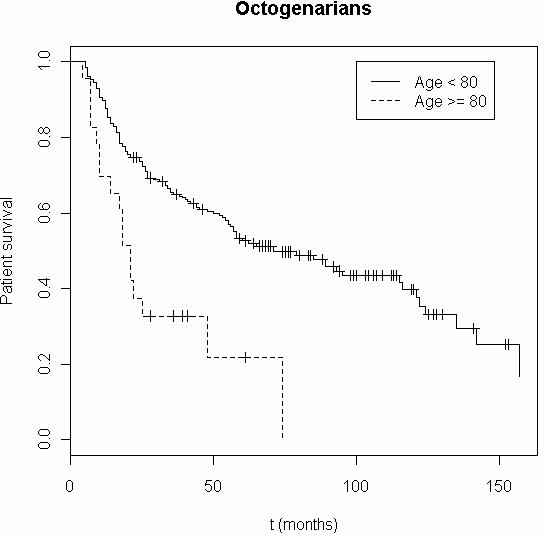
|
 |
Back to Annual Meeting Posters
Esophagectomy for Cancer Can Be Performed Safely and With Good Perioperative Outcomes in Octagenerians
Vadim P. Koshenkov*1, Tulay Koru-Sengul2, Angela T. Prescott1, Carlo Maria Rosati1, Monika E. Freiser1, Danny Yakoub1, Alan S. Livingstone1
1Surgery, University of Miami, Miami, FL; 2Epidemiology, University of Miami, Miami, FL
Introduction: The number of elderly patients that are being diagnosed with cancer in the United States has risen, as lifespan has increased. Consequently, octogenarians are now considered more frequently for operations with high rates of mortality and morbidity, such as esophagectomy. Inconsistent data exists regarding the outcomes of esophagectomy in this population group.
Methods: A retrospective review was performed for patients that had undergone esophagectomy for cancer at a tertiary care referral center from 1/2000 to 6/2012. Clinicopathologic factors and survival data for octogenarians were analyzed and compared to patients who were 79 years old or younger.
Results: Among the 34 patients who met the inclusion criteria, 21 (61.8%) had comorbidities. Of these, pre-existing cardiac disease was identified in 16 (47.1%), pulmonary in 6 (17.6%) and diabetes mellitus in 3 (8.8%). Median age was 82, 76.5% were male, 76.5% had adenocarcinoma that was distal (88.3%), and 50.0% of tumors were poorly differentiated. Stages 0 through III were observed in 2 (5.9%), 6 (17.6%), 9 (26.5%) and 17 (50.0%) patients, respectively. Neoadjuvant chemotherapy or chemoradiotherapy was administered to 25 (73.5%) patients, with 12 (48.0%) undergoing downstaging. Transhiatal esophagectomy was performed in 28 (82.4%) patients, with an r0 resection in 31 (91.2%). Median length of stay (LOS) was 10 days. Mortality and morbidity rates were 5.9% and 44.1%. These were not significantly different from 10 days, 4.4% and 46.1%, respectively, for a group of 293 patients that were 79 years old or younger. Cardiac, pulmonary, and infectious complications were encountered in 17.6%, 14.7%, and 2.9%, respectively. Anastomotic leak occurred in 5 (14.7%) patients, and reoperation rate was 2.9%. Median, 3-year, and 5-year survival were 21 months, 55.9%, and 37.1% respectively. Overall survival was worse for octogenarians when compared to younger patients (p<0.0001)(Figure 1).
Conclusion: Mortality, morbidity and length of stay in octogenarians were comparable to patients who were 79 years old or younger, while the overall survival was worse. With appropriate patient selection, good perioperative outcomes can be accomplished in octogenarians undergoing esophagectomy for cancer.

Back to Annual Meeting Posters
|


